Buy Now
Overview
Please notice that Meteobridges Do not support some proprietary 2.4GHz WLAN high-speed modes (just the regular 802.11 b/g/n are supported) and it also cannot connect to MESH networks, which some routers a providing.
Smartbedded (SB) offer a range of products designed to provide enhanced data handling for automatic weather stations of various makes. The innovative MeteoBridge software/hardware are designed to deliver two main capabilities:
- A simple, turnkey option for uploading weather data from many different models of weather station to websites and to various weather communities such as Wunderground (MeteoBridge);
- Advanced data-handling features which are not achieved easily or cost-effectively by other hardware devices and software programs
All of the SB software products are written to run on tiny, self-contained and cheap Linux-based computers, which are are affordable to use as a dedicated weather computer and which use so little power that they can be left running 24/7 without worry.
 MeteoBridge — MeteoBridge provides an easy-to-use unit for uploading live weather data to communities such as WOW and Wunderground, but also provides advanced features for more experienced users, including website uploads, sophisticated alarms, email, Twitter, webcam uploads etc.
MeteoBridge — MeteoBridge provides an easy-to-use unit for uploading live weather data to communities such as WOW and Wunderground, but also provides advanced features for more experienced users, including website uploads, sophisticated alarms, email, Twitter, webcam uploads etc.
The original standard MeteoBridge has been largely superseded by the Pro version (see below). We no longer sell the standard MB unit but interested users can still build their own standard MB by following instructions on the Smartbedded site (but please be sure that you have a compatible version of your proposed host hardware). Information about the basic MB has been retained below as a general introduction to MB functionality.
MeteoBridge Nano and Nano SD New This is a great new member of the MeteoBridge family which includes all of the standard Meteobridge software features in a logger-sized module AND includes WiFi communication with your domestic or office WiFi network.
MeteoBridge Pro Basic functions are similar to standard MeteoBridge but with many additional enhancements and features, including a MeteoBridge Pro Red version which contains full receiver circuitry for Davis wireless transmitters (MeteoStick is effectively built in).
Important: The MeteoBridge products are designed as an alternative, self-contained data handling system to a traditional Davis logger + PC software solution. While MB products such as Nano do have a pass-through mode that allows current weather data to flow via a network connection on port 22222 to Davis compatible software, this feature does not extend to archive data; so in this specific sense only, MB devices such as Nano are not a complete substitute for traditional Davis loggers.
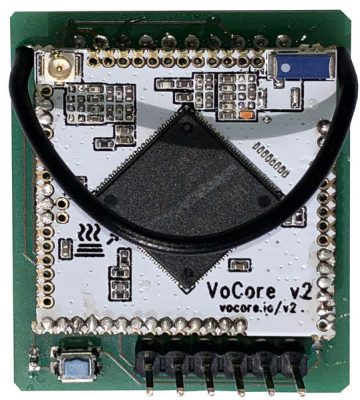
MeteoBridge Nano
This is a great new member of the MeteoBridge family which includes all of the standard Meteobridge software features in a logger-sized module AND includes WiFi communication with your domestic or office WiFi network.
The Meteobridge NANO is a tiny plug-in device that dramatically extends the features of your Davis Instruments® Vantage Pro2™ or Vue™ weather station. The NANO is simply plugged in the expansion connector underneath the battery cover on the back of the console and in exactly the same way as a standard logger. When you close the back cover again this upgrade is completely invisible. The NANO adds a full Meteobridge feature-set to your weather station setup which includes many extra services for which you usually need a full PC solution. The NANO just takes about 1 watt of energy and therefore is dramatically more power efficient than using a PC and more convenient to use than even a Raspberry Pi.
Further details can be found in the Nano datasheet (which also provides details of the Meteobridge services available from Nano) and in the Nano install manual. More description of Meteobridge services will also be found below.
Meteobridge Nano SD
Nano was designed with the capability to accept a special SD card for long-term data storage although this feature has only recently been disclosed. From March 2019 we will be offering both the standard Nano (no SD card) and Nano SD (SD card pre-fitted) as separate products. Nano SD adds considerably to the capabilities of a Vue or VP2 console to act as a standalone device for recording weather data as explained in more detail on the Smartbedded site at: www.meteobridge.com/wiki/index.php/Meteobridge_NANO_SD.
Important: You cannot use a regular SD card with Nano SD – it must be a special industrial SD card with exceptional durability that minimises the risk of data loss. This accounts for the significant extra cost of the Nano SD product.
Nano vs WFL: As a logger communicating (only) over WiFi, the MB Nano product is similar in some respects to the WFL WiFi logger and it’s an obvious question as to how the two devices compare. Each has pros and cons and each has certain unique features; potential users will need to explore the features of each in more detail and reach their own conclusion as to which device better fits their needs.
However, in a nutshell, WFL is simpler and cheaper, but with significant limitations to its capabilities. Nano is somewhat higher-priced but has substantially more powerful data handling features built-in. Either can be used in simple, standalone installations, such as simply uploading to weather networks like Weather Underground. But for more advanced applications, WFL would typically be used with software running on an external computer (albeit with full flexibility as to the choice of software to be used), whereas Nano is designed to deliver many advanced features direct from the built-in Meteobridge software and without necessarily needing additional support from an external computer.
Some additional comments on WFL vs Nano will be found in the WFL FAQ section.
MeteoBridge Pro Red
Usually available from stock
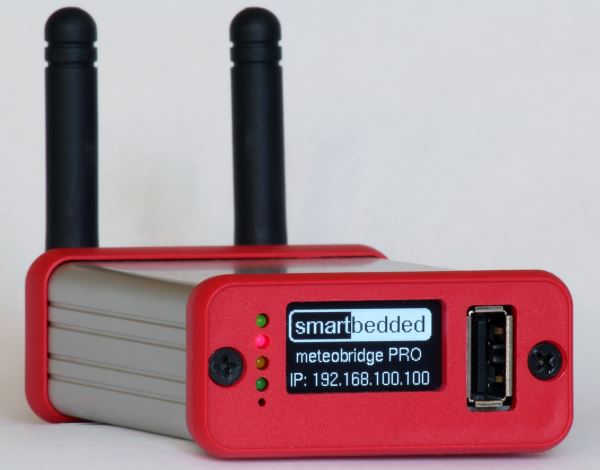
MeteoBridge Pro (MB Pro) is essentially a super-MeteoBridge device – it does everything that the original MB can do but also offers many additional features. In particular, the MB Pro Red is a complete replacement for a standard Davis console/logger – it can receive data direct from the ISS and process it via the built-in Meteobridge software. The key Pro enhancements are:
- The MB Pro software platform is hosted on its own miniature hardware (rather than using some other host unit such as the TP-Link MR3020) and so looks quite different to the original MB;
- The dedicated and customised hardware allows a much neater and higher-performance installation, with built-in (but demountable) higher-gain antennas for wireless functions, a small built-in text display, no need of separate USB hubs etc;
- MB Pro has substantially more memory than the original MB, including built-in access to 8GB USB memory, while still consuming minimal power, and this key difference enables many more software features to be added;
- Available in two models: Black (standard) and Red with built-in MeteoStick circuitry allowing direct reception of data from Davis wireless transmitters.
See the standard MB description below for an overview of MB features.
Overall, the main functional advantage of MB Pro is its greater computing capability made possible by the much larger memory, which gives it the potential to perform many tasks beyond the reach of the original MB. It will take a little time before the software potential of the Pro is fully exploited, but updates to the MB Pro’s software are free and automatic (on reboot). And as the Pro’s user community expands, so will the range of novel applications and downloadable templates & other community resources also doubtless grow.
There are many potential applications of the MB Pro ranging from its use as a supplementary component of overall data handling and display in a more traditional AWS system through to a set-up where the Pro unit becomes the primary element of data and display. An example of the latter type of system would include:
- Davis wireless sensors providing the outside weather sensing;
- An MB Pro Red unit acting as the sole data receiver indoors (ie no console necessary) and as the data hub;
- The small display on the Pro showing an always-on readout of key weather parameters;
- The WiFi output of the MB Pro providing a live feed of weather data for local viewing on eg tablets and phones via web browser templates such as WDL, Steelseries gauges etc;
- The MB Pro handling sophisticated uploads of weather data, for example to Internet communities such as WUnderground and WOW and also managing more comprehensive data uploads to personal or custom websites on remote web servers;
Further details can be found in the MeteoBridge Pro datasheet and in the MeteoBridge Pro manual.
MeteoBridge Pro Black
Meteobridge Pro Black closely resembles the Red version above (other than its black case) and contains all the same MB Pro data handling features, including the ability to access data from a Weatherlink Live unit, except that it contains no tuner circuitry for the VP2 wireless signals (and hence only one antenna – for WiFi). An MB Pro Black unit must therefore be fed data from another source such as a USB or network logger (IP logger or the WiFi Logger) or the Weatherlink Live unit.
In this role, MB Pro Black effectively becomes a small low-power (ie suitable for operation 24/7) computer that is dedicated to handling local weather data received by another device and which provides all the comprehensive set of data features offered by the MB family. This includes the capability to receive all the multi-transmitter data that a Weatherlink Live unit can receive.
So a MB Pro Black unit is very much a recommended companion to a Weatherlink Live receiver for users who wish to have access to a wider choice of uploads to various online weather platforms or to set up sophisticated local data handling.
Classic MeteoBridge
NB The standard Meteobridge unit has been largely replaced by the Pro and Nano units above, especially the Pro Red. We no longer sell the standard MB – anyone still wanting one will find it more cost-effective to make their own, purchasing a firmware download from the MB website.
Compatibility: Most affordable AWS makes/models
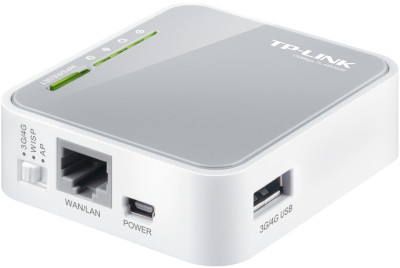 MeteoBridge (MB) is a Linux software program which is sold pre-installed on a tiny Linux computer (see image right for a typical MB device – this one is about 3″ (70mm) square to give an idea of size). So, when buying MeteoBridge you’re effectively buying a small, hardware device, dedicated to running the MB software. (Don’t be put off by the mention of Linux – you need to know absolutely nothing about Linux to use an MB unit. All MB configuration is done using a web interface – see below).
MeteoBridge (MB) is a Linux software program which is sold pre-installed on a tiny Linux computer (see image right for a typical MB device – this one is about 3″ (70mm) square to give an idea of size). So, when buying MeteoBridge you’re effectively buying a small, hardware device, dedicated to running the MB software. (Don’t be put off by the mention of Linux – you need to know absolutely nothing about Linux to use an MB unit. All MB configuration is done using a web interface – see below).
The MB device is a tiny, low power-consumption unit that, once the initial set-up is complete, does not need any routine attention – whenever you power up or reboot the unit, it will restart the MB software automatically and will resume performing the uploads previously configured. It should therefore operate almost as a zero-maintenance unit (other than on occasions when you might choose to change its settings) being left on 24/7 and using so little power as to be negligible, simply working away in the background and performing all your Internet weather uploads. Note also that the MB unit is WiFi enabled and so provides a way of connecting your weather data into your home or office network via WiFi.
The MB unit receives its data input from your weather station console (or data logger) via a USB connection and its output is then connected onwards to your Internet connection either via a cabled connection or via WiFi. When using MB, no USB connection to a separate PC or other computer is needed.
MeteoBridge is compatible with many common makes of weather station, including Davis, Oregon, Fine Offset (Maplin) etc. For a full list of compatible models, please check this link.
Multiple data feeds: Please remember that most consoles and loggers have only one single USB output and so if your weather station is connected to the MB unit, it cannot also be connected to a PC. The main concept behind the MB unit is to provide a simple dedicated means of uploading data to various websites. If you might wish also to run a range of local PC weather software in addition then there is a range of options. For Davis stations only, the latest version of MeteoBridge does provide a pass-through by which the logger data can also be received on one single additional PC, with the data being passed across the network from MB unit to PC (ie and not via the usual USB connection). The software program running on the PC must be able to accept logger data formatted as if being received from a WeatherlinkIP logger on port 22222. Note that this data pass-through is a relatively new feature and is perhaps best regarded as a beta feature for now. Another alternative for Davis stations is to use a separate MeteoStick (see below) receiver to feed data to the MB device and to retain any existing logger/PC operating as now. A further option for wireless stations is to operate a second and independent console/logger to provide the data feed to other software.)
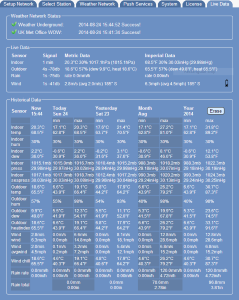 Note that the USB input and network output are the only cable connections that need to be made to the MB device (other than a power cable from the AC mains adapter). No keyboard, mouse or monitor connections are needed at all. Instead, any changes that may occasionally be needed to the MB settings are made via any other PC or tablet on your network via a simple web browser interface – see image right (click for a larger version). This image shows the ‘Live Data’ tab enabled, but the other tab options can be seen across the top of the image.
Note that the USB input and network output are the only cable connections that need to be made to the MB device (other than a power cable from the AC mains adapter). No keyboard, mouse or monitor connections are needed at all. Instead, any changes that may occasionally be needed to the MB settings are made via any other PC or tablet on your network via a simple web browser interface – see image right (click for a larger version). This image shows the ‘Live Data’ tab enabled, but the other tab options can be seen across the top of the image.
So, the commonest use for Meteobridge will be to provide a simple, low-power means of uploading data to weather communities such as Weather Underground, CWOP and WOW (the UK Met Office network), but also including many other open networks and allowing network connection via WiFi as well as cable. (NB ‘Open’ networks meaning services which welcome uploads from third-party software; this obviously cannot include proprietary services like weatherlink.com which only allow uploads from their own eg Davis software and devices.)
But, in addition, MB also provides a set of advanced features called ‘Push Services’. These allow users with slightly more technical interest and background to configure four types of additional service:
- Upload messages and data via Twitter or email,
- Upload data in customised, template-driven formats to websites and SQL databases on (usually remote) servers;
- Upload images from compatible webcams;
- Set sophisticated alarm/alert thresholds with notifications by email or text message.
These Push Services are a powerful and sophisticated feature and in the hands of an interested user permit a wide range of advanced applications to be developed, giving some features that are simply not readily possible with other software. Further details about these Push Services can be found in the MeteoBridge wiki. Alternatively, prospective buyers can contact us with any specific questions.
MeteoStick
This product is no longer sold by Prodata, please contact Smartbedded directly.
Compatibility: Davis wireless only
Overview
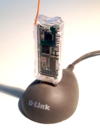 MeteoStick (MS) is a revolutionary new product. It is a receiver for wireless data from Davis Vantage sensor transmitters, including all transmitters in the VP2 range and the Vue sensor transmitter. (MS is obviously not compatible with Davis cabled stations.)
MeteoStick (MS) is a revolutionary new product. It is a receiver for wireless data from Davis Vantage sensor transmitters, including all transmitters in the VP2 range and the Vue sensor transmitter. (MS is obviously not compatible with Davis cabled stations.)
MeteoStick (MS) is a revolutionary new product. It is a receiver for wireless data from Davis Vantage sensor transmitters, including all transmitters in the VP2 range and the Vue sensor transmitter. (MS is obviously not compatible with Davis cabled stations.)
MeteoStick is manufactured in the form of a transparent USB memory stick (see image below right – click to enlarge) and therefore simply needs to plug into the USB socket on a PC or other small computer in order to provide a data feed to the computer and also to draw power for itself. The orange element to the right of the MS unit is an external stiff wire antenna. The MS unit can also be plugged into a cabled USB socket (see left), which will achieve the best wireless range because the MS is removed from the immediate vicinity of the computer.
MeteoStick clearly does not have a display of its own and so can only act as a data receiver when connected to a computer. In this sense, it offers comparable capabilities to a Davis Envoy console, but note that it plugs directly into a computer (or USB socket) and so replaces both Envoy and the Weatherlink logger that would otherwise be required for connecting Envoy and PC.
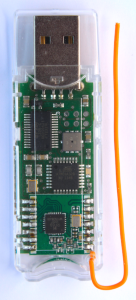 In fact, MeteoStick can receive data from any combination of Davis transmitters on the eight available wireless channels and so the MS unit is closer to the Envoy8X than the plain Envoy unit. This multi-transmitter capability makes the MS unit a potentially very powerful hardware device when used with innovative software solutions. MeteoStick does have a high-quality, built-in sensor for atmospheric pressure and so can generate barometer readings. (NB MeteoStick does not have any inbuilt logging capacity and so must pass received data directly to a computer such as the MeteoBridge unit described above. Experimental support for use of MeteoStick with Davis wireless repeaters, a feature which was not previously available, has just (March 2015) been introduced in a new firmware upgrade – please contact us for further details if you might be interested in using this capability.)
In fact, MeteoStick can receive data from any combination of Davis transmitters on the eight available wireless channels and so the MS unit is closer to the Envoy8X than the plain Envoy unit. This multi-transmitter capability makes the MS unit a potentially very powerful hardware device when used with innovative software solutions. MeteoStick does have a high-quality, built-in sensor for atmospheric pressure and so can generate barometer readings. (NB MeteoStick does not have any inbuilt logging capacity and so must pass received data directly to a computer such as the MeteoBridge unit described above. Experimental support for use of MeteoStick with Davis wireless repeaters, a feature which was not previously available, has just (March 2015) been introduced in a new firmware upgrade – please contact us for further details if you might be interested in using this capability.)
It’s important to recognise that MeteoStick has its own specific data protocol or API and so can only pass data to software programs that have a driver or interface for this API. To be clear, MS uses a very different API from the standard Davis API and so is not automatically going to be compatible with programs that cater only for the standard Davis interface. At present, MeteoStick caters for two types of software application:
- All of the other SB software products (MeteoBridge – see above, MeteoHub and MeteoPlug) are fully compatible with a data feed from MeteoStick. MeteoBridge is probably an ideal companion to MeteoStick because the combination provides a fully autonomous unit able to support uploads to Weather Underground (including RapidFire), to WOW and to various other websites and databases;
- The API for MS is fully published (see the MeteoStick PDF manual and so any user with programming or scripting skills can easily write their own software. Moreover, the sensor data is available at the level of the individual transmitter packet types, which gives more granularity and flexibility in processing the sensor data;
We do also expect that other established software programs are likely to add support for MS in the coming months.
Potential Applications
Meteostick is a fascinating new product, but one that will be unfamiliar as yet to many users, so perhaps we can suggest a few potential applications. In general, we recommend using MS in addition to a standard Davis console so that you retain a local real-time LCD display. We also suggest that you’ll find the combination of MS with MeteoBridge as a very flexible and cost-effective alternative to running a second console/logger for scenarios where the data feed from a first console/receiver cannot deliver the full range of uploads and features that may be required. Potential applications include:
MS+MB can provide services that conventional Davis Weatherlink does not support, such as automatic uploads to the UK Met Office’s WOW service, reliable Wunderground RapidFire uploads, fully flexible alarms or alerts via email, Twitter etc;
MS+MB can also receive data from transmitter combinations that cannot be accessed by standard VP2 and Vue consoles. For example, an anemometer transmitter CAN be fitted with solar and UV sensors (as well as anemometer) and the data all received by the MB unit. (Indeed, an IM Sunshine Hours recorder could also be attached to the rain gauge input);
The combination of MS+MB can be linked into an existing WiFi network using the WiFi option of MB;
As noted above, the MS unit offers considerable scope for users to write their own custom software;
Buy Now
